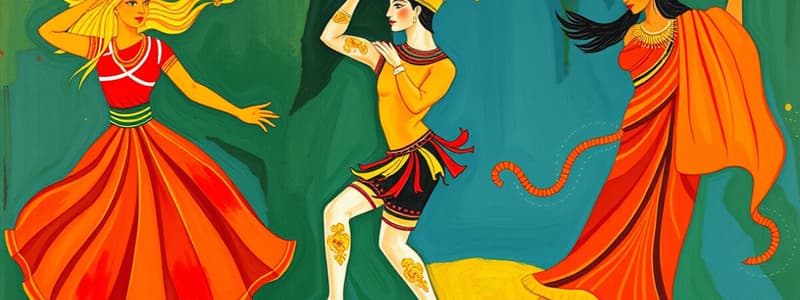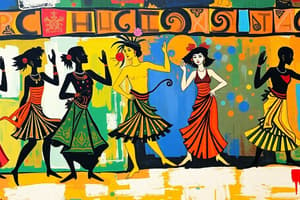Podcast
Questions and Answers
What was one of the earliest purposes of dance in the prehistoric era?
What was one of the earliest purposes of dance in the prehistoric era?
- To record historical events
- To appease the forces of nature (correct)
- To serve as a form of entertainment
- To attract mates
How was dance perceived in Ancient Greece?
How was dance perceived in Ancient Greece?
- As a primary form of religious worship
- As a tool for military education and entertainment (correct)
- As a discouragement of physical activity
- As a sacred ritual with no public display
What shift occurred regarding dance after the rise of the Catholic Church?
What shift occurred regarding dance after the rise of the Catholic Church?
- Dance became a theatrical performance allowed in public
- Dance was prohibited except during worship and ceremonies (correct)
- Dance was viewed as an essential part of education
- Dance was encouraged as a talent among nobility
What impact did the Roman Empire's wealth have on dance?
What impact did the Roman Empire's wealth have on dance?
Which philosophers supported the integration of dance in education?
Which philosophers supported the integration of dance in education?
What role did dance play during the Dark and early Middle Ages?
What role did dance play during the Dark and early Middle Ages?
How did the perception of dance change over time during the Roman Empire's later days?
How did the perception of dance change over time during the Roman Empire's later days?
Which statement best describes the status of dance in Ancient Egypt?
Which statement best describes the status of dance in Ancient Egypt?
Flashcards are hidden until you start studying
Study Notes
Prehistoric and Ancient Civilizations
- Early humans performed dances to appease nature and gain powers.
- Growth of dance knowledge occurred during the pre-Christian era in Mediterranean and Middle Eastern cultures.
- Ancient Egyptian civilization documented dance through wall paintings, reliefs, and hieroglyphics.
Dance in Ancient Greece
- Valued highly, dance was integrated into military training for boys in Athens and Sparta.
- Philosophers like Plato, Aristotle, and Socrates advocated dance as vital to education, emphasizing the interconnection between body and soul.
Roman Attitudes Toward Dance
- Ancient Rome eventually devalued dance amidst its wealth and power, leading to sensationalized and brutal performances.
- Dance became associated with the moral decay of the empire, ultimately condemned by early Christians.
Transformation Post-Rome
- The Catholic Church emerged as a dominant cultural authority, restricting dance to religious contexts and ceremonies.
- While theatrical entertainment was banned, itinerant performers (singers, dancers, musicians) continued to entertain in village squares during the Dark Ages.
Emergence of Social and Court Dance
- Performers were later embraced by feudal lords, marking a shift towards social dancing among common people.
- Nobility adopted these dances, refining them into courtly forms, integrating dance into the chivalric way of life.
Renaissance Influence
- The Renaissance saw a revival of dance and art, breaking past restraints and allowing creative expression to flourish.
- Entertainers became important figures in the courts of Italy and France, enhancing the cultural landscape of the era.
Studying That Suits You
Use AI to generate personalized quizzes and flashcards to suit your learning preferences.




